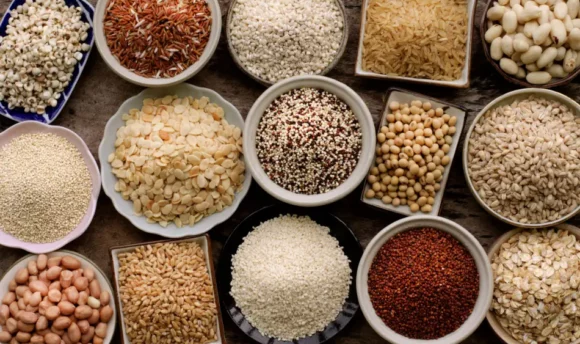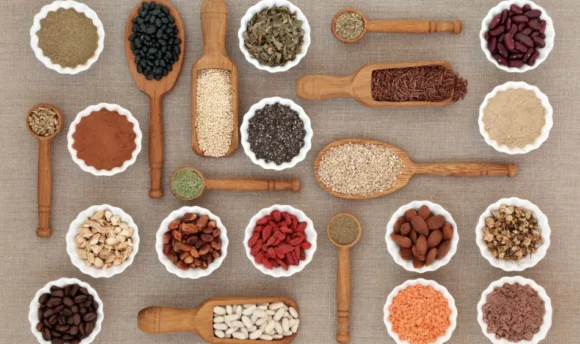Brown Rice vs. White Rice: Breaking Down the Myths and Facts
Discover the differences and make a healthier choice for you

From China and Japan to Europe and the United States, rice is a staple food across the world. This versatile grain comes in a variety of shapes and sizes, along with different colors.
However, the two most commonly consumed types of rice in the US are brown and white rice, which are popular accompaniments to curries, stir-fries, and even simple meat dishes. These varieties offer slightly different tastes, textures, and benefits, but which is better health-wise?
Brown Rice vs White Rice: The Basics
Before we jump into a detailed comparison of brown and white rice, you may be wondering what the main differences are between the two varieties. So, we’ve explored the basics below:
What is Brown Rice?
Brown rice is a type of whole grain, meaning its complete grain remains intact. The grain includes three distinct parts: the bran, germ, and endosperm.
While most of the rice’s fiber can be found in the outer bran, the germ is filled with important vitamins and minerals, and the endosperm contains carbohydrates. Brown rice generally takes longer to cook due to the bran, which needs to be penetrated by water to replicate the softness of white rice.
Despite being more dense, and having a tougher, chewy texture, cooked brown rice has a slightly nutty flavor. This gives it a slightly more unique taste in comparison to its white counterpart.
What is White Rice?
White rice cooks quicker than the brown variety and offers a much softer texture, which is why it is often the preferred choice for many. This is because the grain goes through a refining process, which removes the tough bran exterior and the germ, leaving only the starchy endosperm.
These parts of the grain are where most of the nutritional value is held, meaning that white rice has fewer essential nutrients than brown rice.
Nutritional Comparison
No matter the type, all rice is composed mainly of carbohydrates, which is the body’s main energy source. It also contains small amounts of protein, yet no fat.
To give you a more in-depth look at the differences between brown and white rice, here’s a comparison of their nutritional compositions per 100 grams when raw:
| Brown rice | White rice | |
| Calories | 367 | 365 |
| Carbohydrates | 76.2 grams | 80 grams |
| Fiber | 3.6 grams | 1.3 grams |
| Calcium | 9 milligrams | 28 milligrams |
| Iron | 1.29 milligrams | 0.8 milligrams |
| Magnesium | 116 milligrams | 25 milligrams |
| Potassium | 250 milligrams | 115 milligrams |
As mentioned, brown rice generally contains a higher percentage of vitamins and minerals because it doesn’t go through a refining process. Some of the nutrients that are lost during this process are artificially added back into enriched white rice to counteract this.
For instance, brown rice is packed with magnesium, which is responsible for the action of more than 300 enzymes throughout the body. Some of its stand-out benefits include promoting good heart health, maintaining healthy bones, and even improving your sleep.
Brown rice also contains more iron, a mineral important for making hemoglobin. This is a protein that assists red blood cells in carrying oxygen around the body, aiding healthy growth and hormone production. Failing to consume enough foods high in iron can lead to anemia, a common deficiency causing fatigue, lightheadedness, and even hair loss.
Both types of rice are high-potassium foods. Like magnesium, this is an essential mineral and electrolyte that maintains fluid balance, along with keeping your blood sugar levels healthy and aiding muscle recovery.
Health Benefits and Risks
Although cooked brown rice is generally a healthier food in terms of the nutrients it offers, both types have their own benefits that make each one a better choice for different people. Let’s take a closer look at the advantages and drawbacks of white and brown rice:
Health Benefits
As the bran layer remains intact, brown rice offers a much higher antioxidant and fiber content than the white variety.
This is important, as these nutrients offer many health benefits for your body. For example, the antioxidants found in brown rice play a key role in neutralizing harmful free radicals, which can contribute to chronic diseases like cancer, type 2 diabetes, and heart disease.
Consuming plenty of fiber helps to keep your heart healthy by lowering “bad” LDL cholesterol levels, increasing “good” HDL cholesterol, and reducing blood pressure. It can also help to tackle inflammation, which lowers the risk of cardiovascular disease.
Along with its heart health benefits, choosing fiber-filled brown rice also keeps your digestive system working smoothly. The nutrient softens and adds bulk to your stool to prevent constipation and diarrhea, while also feeding the good bacteria throughout your gastrointestinal tract to help maintain a healthy gut.
Finally, getting more fiber into your diet with whole grains such as brown rice helps you to feel fuller for longer, as they are digested more slowly. This can naturally lower calorie consumption for those hoping to lose weight.
For instance, in one study involving 40 overweight or obese women, those who consumed brown rice significantly reduced their body weight and waist size compared with those eating cooked white rice.
Health Considerations
Unlike the brown variety, white rice has a relatively high glycemic index (GI) at 89, compared with 50. This index rates foods based on how quickly they cause your blood sugar to rise. High GI foods rapidly cause blood sugar levels to rise and fall, triggering the pancreas to produce more insulin.
These spikes can also cause food cravings, meaning you’re more likely to overeat. Over time, these factors may lead to insulin resistance and weight gain, increasing your risk of developing type 2 diabetes.
Cooking white rice a day in advance, cooling it, and then reheating it can impact its glycemic index (GI). This process increases the formation of resistant starch in the rice. Resistant starch is not fully digested in the small intestine and instead reaches the colon. Here, it acts as a prebiotic, feeding the beneficial bacteria in the gut. These bacteria then produce short-chain fatty acids like butyrate.
Butyrate serves as a primary energy source for colon cells and may be beneficial to health. In addition to reducing inflammation in the gut, it may lower the risk of certain colon diseases. While butyrate may reduce the risk of colon cancer and alleviate symptoms of digestive disorders such as Crohn’s disease and ulcerative colitis, further research is needed to prove its effectiveness.
Making the Right Choice for Your Diet
When it comes to choosing between brown and white rice, there are several important considerations that you’ll need to make, including your dietary and health needs.
For those looking to up their fiber intake or find weight loss foods, brown rice is a better option for keeping you fuller for longer and reducing food cravings. It has a more balanced nutritional profile and is packed with important nutrients and antioxidants.
As a low-GI food, brown rice is also the best choice if you’re looking to manage your blood sugar levels, tackle insulin resistance, or lower the risk of type 2 diabetes and heart disease.
However, if you’re struggling with stomach discomfort, heartburn, or nausea, you may benefit from choosing white rice over the brown variety. This is because, despite its long list of health benefits, brown rice contains phytic acid, a substance that makes foods more difficult to digest.
As an anti-nutrient, phytic acid can also lower your body’s ability to absorb important nutrients like iron and zinc. In order to keep some of its nutritional value, brown rice needs to be soaked before cooking.
Furthermore, white rice is more effective as part of a pre-workout meal eaten around 2 hours before exercising. It provides simple carbohydrates that are easier to digest than brown rice, and offers a quick energy boost to support your performance.
A Word From Our RD


Despite being lower in fiber than the whole-grain brown variety, a few servings of white rice can make a perfectly good addition to any balanced diet. However, you’ll need to up the fiber content of your meals by serving it with healthy foods such as avocado, non-starchy vegetables like broccoli and cabbage, pumpkin seeds, and legumes such as lentils and beans.
Another way to ensure you’re hitting your fiber goals is by making small swaps each day, such as replacing sugary breakfast cereals with oatmeal and berries, keeping fiber-rich snacks on hand, and even adding a fiber supplement into your routine.
If you choose white rice, incorporate other whole grains into your diet to maintain good digestive and cardiovascular health. Some great examples include quinoa, oats, barley, and buckwheat.
FAQs
Rice is considered to be part of the grain food group, along with oats, barley, wheat, and cornmeal. Rice can either be a whole grain, meaning that the grain is kept intact, or refined, where the outer bran and germ are removed.
White rice is high on the glycemic index (GI), meaning that it can cause your blood sugar levels to rise and fall quickly. Over time, this can cause insulin resistance, which increases your risk of diabetes. However, the risk can be lowered by eating white rice in moderation as part of a balanced diet.
Yes, brown rice is a whole grain, with all three bran, germ, and endosperm layers intact. In contrast, white rice is a refined grain with the bran and germ removed.
Brown rice is a high-fiber food. This is because, unlike white rice, the outer bran layer is kept intact, which is where most of the grain’s fiber can be found. High-fiber foods offer several benefits, including keeping your digestive system moving and helping to maintain a healthy heart.
Swapping white rice for the brown variety can help with weight loss as it is full of fiber. This is an important nutrient that helps keep you fuller for longer, naturally lowering your calorie consumption. However, to lose weight, you’ll need to ensure that you’re burning more calories than you’re consuming through diet and exercise.
Conclusion: Which Rice Wins?
When comparing brown and white rice, the main difference between the two arises from the refining process that removes the nutritious bran and germ layers. With a higher fiber, antioxidant, and vitamin and mineral content, brown rice is generally considered to be a healthier choice.
While brown rice offers a more complete nutrient profile, either variety can be incorporated into a healthy diet. Along with your preference for taste and texture, the type that you choose should depend on your health and wellness goals, particularly if blood sugar management is a key priority.
If you’re unsure of whether brown or white rice is best for you, speak to a doctor or registered dietician for personalized advice.

















































 Select your language:
Select your language: 







